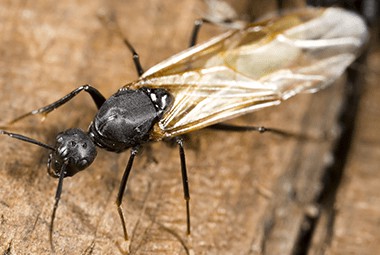
Carpenter ants are a destructive ant species that tunnel through wood in order to create nesting areas. If carpenter ants enter your home and decide to nest within the walls, it can lead to significant and dangerous structural damage that can be quite expensive to repair.
| Pest Identification | |
|---|---|
| Recognition | Carpenter ants can be black, red, yellowish, or a combination of either in color depending on the species. Adults can grow to be 5/8th to ½ of an inch in length; sometimes queens can grow up to 1 inch in length. They have an oval shaped segmented body, six legs, and antennae; and workers have large, strong mandibles. They can be distinguished from other ant species by their one node waist and their thorax that has an evenly rounded upper surface. |
| Biology | Carpenter ants choose areas that are high in moisture to build their primary colonies in. The developing eggs that are inside of the nest are very sensitive to humidity levels and have very specific moisture needs. Once a carpenter ant colony is started it can take 3 to 6 years for it to reach its full maturity. When the primary nest has reached maturity, the colony will start to create satellite nests. Inside of satellite nests live older larvae, pupae, and some winged ants. These nests can be built anywhere, even in dry locations, since they do not house any eggs. Winged reproductive members will swarm (fly) from a mature colony when the weather is warm and humid. The females and males mate and then the males die off. The fertilized queens discard their wings and locate a suitable area to build a new primary nest in. The queens then lay their first batch of eggs and start the life cycle over once again. |
| Habits | Carpenter ants invade wood in order to build nesting areas. They do not eat the wood that they are excavating; they only remove it as they create their tunnels. Carpenter ants feed on proteins and sugars. As they forage for food outdoors, they find and feed on insects and honeydew (a sweet liquid that is left behind by aphids and scale insects).It is very common for carpenter ants to find their way inside of homes while foraging for food. They enter through cracks in foundations and gaps found around windows and doors. Once inside they contaminate and feed on pet food, meat, syrups, honey, and any other sweets that they find. Workers generally only travel about 100 yards from their nest while foraging for food. Finding carpenter ants in or around your home foraging for food is a very good indicator that there is a nesting site located somewhere nearby. |
| Prevention | Carpenter ants require moisture to live. Reducing areas of moisture around your home is one of the best ways to prevent a problem with carpenter ants. Inspect your gutters and make sure that they are properly draining water away from your home, replace any water-damaged wood located in or on your home, and use de-humidifiers in basements and crawl spaces. Other things that you can do to help prevent a carpenter ant infestation include: keeping firewood stored away from the outside of your home, trimming trees and bushes away from walls of your house, and sealing any possible entry points into your home. |
| Professional | Professional control is necessary when dealing with a carpenter ant infestation. All of the foraging ants, the primary colony, and all satellite colonies need to be found and eliminated to truly control a carpenter ant infestation. At Rottler, our experienced technicians will come and inspect your home and property to determine where you have problems with carpenter ants-inside, outside or both. Next, our technicians will locate and treat any and all nesting areas using the appropriate residual or non-residual insecticides inside of your home depending on the situation. Outside we will provide perimeter barrier treatments with water-based residual formulas. Depending on the severity of the infestation we may also treat utility poles, the bases of trees, and may place insecticide bait outside to try and catch any rogue ants. Implementing a year-round pest management program will help to control future problems carpenter ants and other household pests may pose. |

